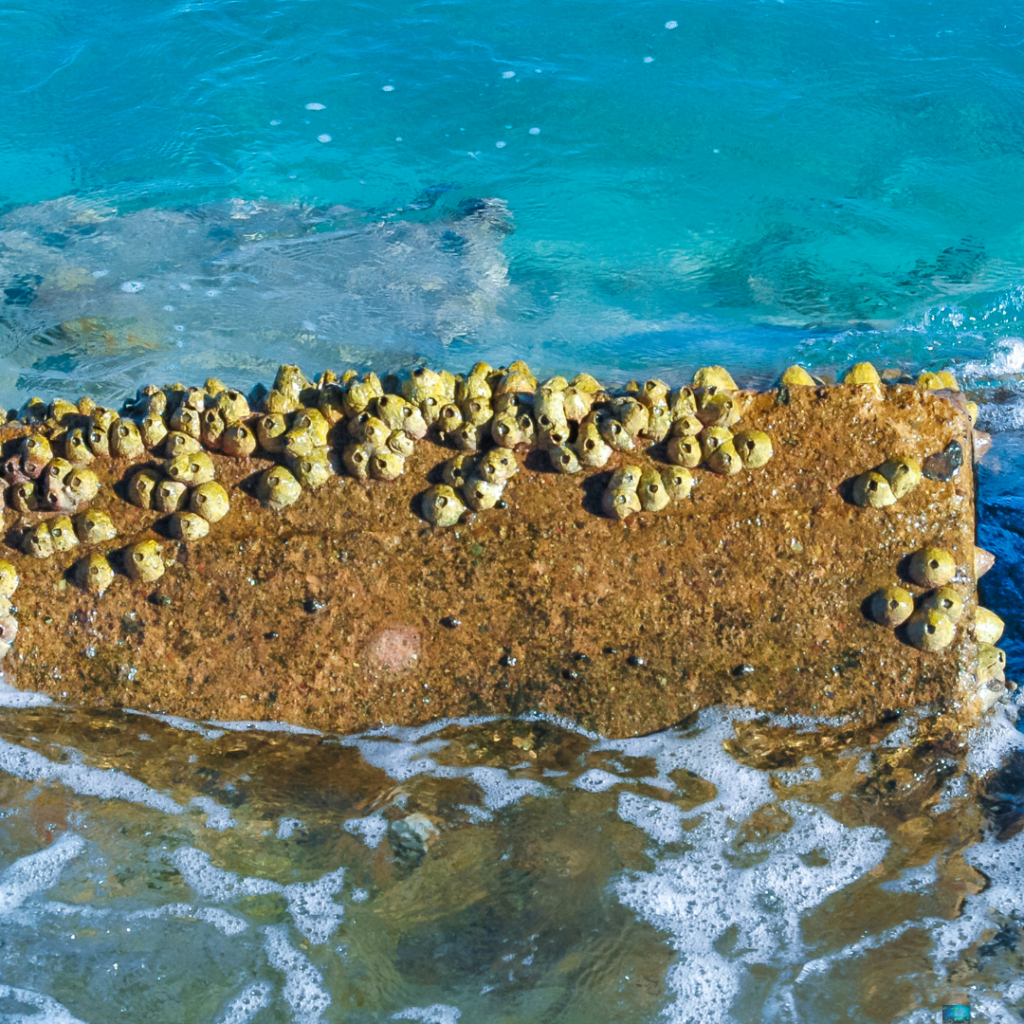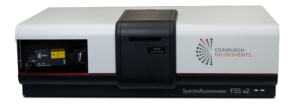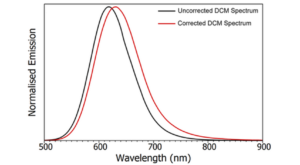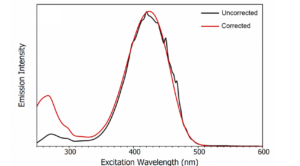In this Research Highlight, photoluminescence analysis is carried out to characterise a coumarin-based antibacterial compound used to prevent fouling in marine environments. The compound was tested in two forms: grafted onto waterproof SiO2-coated rare earth phosphorescent powder and non-grafted. The compound’s excitation, fluorescence, and phosphorescence spectra were acquired using an Edinburgh Instruments FS5 Spectrofluorometer. Afterglow effects were also studied by using the FS5’s kinetic scan function. This approach captures photoluminescence decay over time after excitation stops. The results showed that the grafted sample has a prolonged afterglow, suggesting potential applications in areas where sustained night-time illumination is valuable. These findings open doors for innovative uses of coumarin-based materials in low-light environments.
Any marine equipment in contact with or submerged in a seawater environment is prone to marine fouling. This is the growth and adhesion of aquatic organisms, such as algae, on the surface of the marine equipment. Its presence can result in increased fuel consumption and a dramatic rise in maintenance costs.
Current methods for fouling prevention involve using materials with added natural antifouling agents, detachment characteristics and low surface energy. Materials with excellent photoluminescence (PL) properties have proven to be an alternative option, as the presence of light plays a crucial role in preventing fouling. Light can disrupt the growth and metabolism of algal cells, which rely on photosynthesis. This disruption forces the cells to undergo photosynthesis rather than sedimentation, reducing the overall fouling impact.
Coumarins are a candidate material with antifouling characteristics. They can be used in diverse biological activities, exhibit UV absorption, and have antibacterial properties. Researchers at Hainan University tested 7-amino-4-methylcoumarin grafted onto phosphorescent powder. The sample was then complexed with PVA to compose an antibacterial hydrogel that exhibited excellent mechanical properties, low surface energy, and low antibacterial contact inhibition to achieve an all-weather antifouling effect (Figure 1). Its PL performance was studied using an Edinburgh Instruments FS5 Spectrofluorometer. The material was also tested in a natural marine environment for 180 days, and the results showed an efficiently reduced coverage area by dead bacteria and algae cells. The study’s findings can be applied to various applications, including sea surface vessels, bay ports, and sea bridges, offering a promising solution for marine pollution prevention. The results were recently published in ACS Applied Materials and Interfaces.
Figure 1 Conceptual illustration of 7-amino-4-methylcoumarin grafted onto phosphorescent powder in a hydrogel with all-weather antifouling properties. Adapted with permission from “Advanced Marine Antifouling Hydrogels Based on 7-Amino-4-methylcoumarin Fluorescence Driven by Rare-Earth Phosphorescence”, Q. Mao, S. Liu, Y. Xiong, D. Hu, L. Huang, Z. Fang, H. Jiang, H. Wang, J. Li, S. Mao, and G. Wang, ACS Applied Materials & Interfaces 2023 15 (49), 57582-57592, DOI: 10.1021/acsami.3c12710. Copyright 2023 American Chemical Society.
An Edinburgh Instruments FS5 Spectrofluorometer (Figure 2) equipped with its main excitation source, a 150 W Xenon lamp, was used to acquire the excitation, fluorescence, and phosphorescence emission spectra of the 7-amino-4-methylcoumarin compound. The compound’s kinetics was also measured to study the sample’s afterglow effect.
Figure 2 Edinburgh Instruments FS5 Spectrofluorometer.
For the PL analysis, two forms of the coumarin-based material were measured. The first was grafted onto waterproof SiO2-coated rare earth phosphorescent powder, and the second was measured as nongrafted. For reference, the PL characteristics of the phosphorescent powder were also acquired. Figure 3a shows an optical image of the grafted 7-amino-4-methylcoumarin (labelled as grafted phosphor), non-grafted 7-amino-4-methylcoumarin and the phosphorescent powder (phosphor).
The FS5 was used to characterise the suitability of the samples’ optical properties. The spectral measurements were acquired for the phosphorescent powder (red curve), the non-grafted 7-amino-4-methylcoumarin (blue curve) and the grafted 7-amino-4-methylcoumarin (black curve). Figure 3b shows the excitation spectra of the samples. It can be seen that the grafted coumarin-based sample exhibits a broad UV excitation band, indicating strong absorption properties. The FS5 has a reference detector for automatic excitation intensity correction during excitation spectra and emission correction for emission spectra. Figure 3c shows the samples’ emission spectra, highlighting the UV PL of the non-grafted sample (blue curve) and the PL emission in the visible spectral region of the same compound after grafting with the phosphorescent powder (black curve). This result demonstrates that the phosphorescent powder stimulates the PL of 7-amino-4-methylcoumarin, allowing the grafted sample to be re-excited at night after absorbing light in the day.
To study the afterglow duration of the materials the kinetic scan function of the FS5 was used. In a kinetic scan, the sample is excited, the excitation stops, and the luminescence of the sample is recorded as a function of time. Such a measurement can be seen in Figure 3d, which shows the kinetic scan of the phosphorescent powder (in red) and the grafted sample (in black). The data showed that the grafted sample can exhibit long-term afterglow characteristics.
Figure 3 a) Optical image of all materials. b) Excitation spectra of the grafted, non-grafted coumarin-based sample and the phosphorescent powder. c) PL response of all materials, and d) afterglow of the grafted material and the phosphorescent powder. Adapted with permission from “Advanced Marine Antifouling Hydrogels Based on 7-Amino-4-methylcoumarin Fluorescence Driven by Rare-Earth Phosphorescence”, Q. Mao, S. Liu, Y. Xiong, D. Hu, L. Huang, Z. Fang, H. Jiang, H. Wang, J. Li, S. Mao, and G. Wang, ACS Applied Materials & Interfaces 2023 15 (49), 57582-57592, DOI: 10.1021/acsami.3c12710. Copyright 2023 American Chemical Society.
Researchers from Hainan University developed 7-amino-4-methylcoumarin grafted onto a rare-earth phosphorescent powder in a hydrogen gel form and successfully tested it as a marine antifouling material. The sample’s PL and afterglow performance were studied using an Edinburgh Instruments FS5 Spectrofluorometer. The results showed efficient PL emission and long-lasting afterglow characteristics. These promising results can pave the way for developing antifouling gels to prevent marine pollution.
The results shown in this Research Highlight were published in ACS Applied Materials & Interfaces and are available at https://pubs.acs.org/doi/10.1021/acsami.3c12710.



